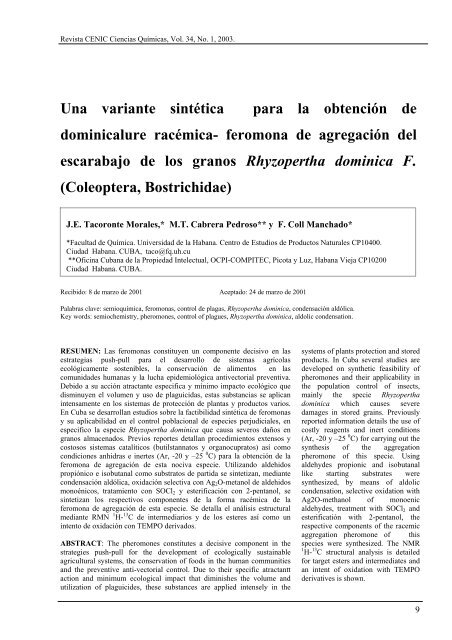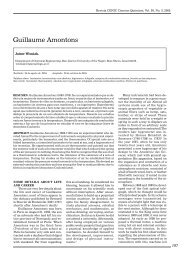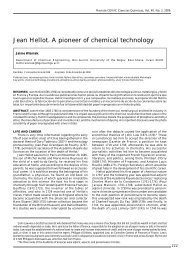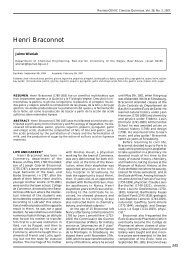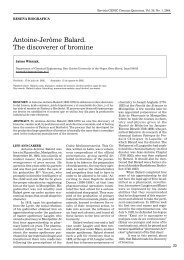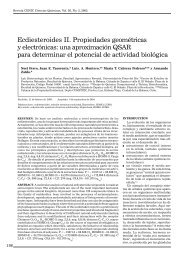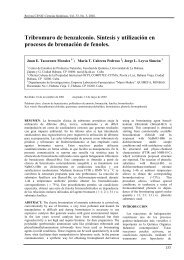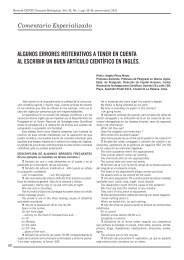Una variante sintética para la obtención de dominicalure
Una variante sintética para la obtención de dominicalure
Una variante sintética para la obtención de dominicalure
Create successful ePaper yourself
Turn your PDF publications into a flip-book with our unique Google optimized e-Paper software.
Revista CENIC Ciencias Químicas, Vol. 34, No. 1, 2003.<br />
<strong>Una</strong> <strong>variante</strong> <strong>sintética</strong> <strong>para</strong> <strong>la</strong> <strong>obtención</strong> <strong>de</strong><br />
<strong>dominicalure</strong> racémica- feromona <strong>de</strong> agregación <strong>de</strong>l<br />
escarabajo <strong>de</strong> los granos Rhyzopertha dominica F.<br />
(Coleoptera, Bostrichidae)<br />
J.E. Tacoronte Morales,* M.T. Cabrera Pedroso** y F. Coll Manchado*<br />
*Facultad <strong>de</strong> Química. Universidad <strong>de</strong> <strong>la</strong> Habana. Centro <strong>de</strong> Estudios <strong>de</strong> Productos Naturales CP10400.<br />
Ciudad Habana. CUBA, taco@fq.uh.cu<br />
**Oficina Cubana <strong>de</strong> <strong>la</strong> Propiedad Intelectual, OCPI-COMPITEC, Picota y Luz, Habana Vieja CP10200<br />
Ciudad Habana. CUBA.<br />
Recibido: 8 <strong>de</strong> marzo <strong>de</strong> 2001 Aceptado: 24 <strong>de</strong> marzo <strong>de</strong> 2001<br />
Pa<strong>la</strong>bras c<strong>la</strong>ve: semioquímica, feromonas, control <strong>de</strong> p<strong>la</strong>gas, Rhyzopertha dominica, con<strong>de</strong>nsación aldólica.<br />
Key words: semiochemistry, pheromones, control of p<strong>la</strong>gues, Rhyzopertha dominica, aldolic con<strong>de</strong>nsation.<br />
RESUMEN: Las feromonas constituyen un componente <strong>de</strong>cisivo en <strong>la</strong>s<br />
estrategias push-pull <strong>para</strong> el <strong>de</strong>sarrollo <strong>de</strong> sistemas agríco<strong>la</strong>s<br />
ecológicamente sostenibles, <strong>la</strong> conservación <strong>de</strong> alimentos en <strong>la</strong>s<br />
comunida<strong>de</strong>s humanas y <strong>la</strong> lucha epi<strong>de</strong>miológica antivectorial preventiva.<br />
Debido a su acción atractante especifica y mínimo impacto ecológico que<br />
disminuyen el volumen y uso <strong>de</strong> p<strong>la</strong>guicidas, estas substancias se aplican<br />
intensamente en los sistemas <strong>de</strong> protección <strong>de</strong> p<strong>la</strong>ntas y productos varios.<br />
En Cuba se <strong>de</strong>sarrol<strong>la</strong>n estudios sobre <strong>la</strong> factibilidad <strong>sintética</strong> <strong>de</strong> feromonas<br />
y su aplicabilidad en el control pob<strong>la</strong>cional <strong>de</strong> especies perjudiciales, en<br />
especifico <strong>la</strong> especie Rhyzopertha dominica que causa severos daños en<br />
granos almacenados. Previos reportes <strong>de</strong>tal<strong>la</strong>n procedimientos extensos y<br />
costosos sistemas catalíticos (butilstannatos y organocupratos) así como<br />
condiciones anhidras e inertes (Ar, -20 y –25 0 C) <strong>para</strong> <strong>la</strong> <strong>obtención</strong> <strong>de</strong> <strong>la</strong><br />
feromona <strong>de</strong> agregación <strong>de</strong> esta nociva especie. Utilizando al<strong>de</strong>hidos<br />
propiónico e isobutanal como substratos <strong>de</strong> partida se sintetizan, mediante<br />
con<strong>de</strong>nsación aldólica, oxidación selectiva con Ag2O-metanol <strong>de</strong> al<strong>de</strong>hidos<br />
monoénicos, tratamiento con SOCl2 y esterificación con 2-pentanol, se<br />
sintetizan los respectivos componentes <strong>de</strong> <strong>la</strong> forma racémica <strong>de</strong> <strong>la</strong><br />
feromona <strong>de</strong> agregación <strong>de</strong> esta especie. Se <strong>de</strong>tal<strong>la</strong> el análisis estructural<br />
mediante RMN 1 H- 13 C <strong>de</strong> intermediarios y <strong>de</strong> los esteres así como un<br />
intento <strong>de</strong> oxidación con TEMPO <strong>de</strong>rivados.<br />
ABSTRACT: The pheromones constitutes a <strong>de</strong>cisive component in the<br />
strategies push-pull for the <strong>de</strong>velopment of ecologically sustainable<br />
agricultural systems, the conservation of foods in the human communities<br />
and the preventive anti-vectorial control. Due to their specific atractantt<br />
action and minimum ecological impact that diminishes the volume and<br />
utilization of p<strong>la</strong>guici<strong>de</strong>s, these substances are applied intensely in the<br />
systems of p<strong>la</strong>nts protection and stored<br />
products. In Cuba several studies are<br />
<strong>de</strong>veloped on synthetic feasibility of<br />
pheromones and their applicability in<br />
the popu<strong>la</strong>tion control of insects,<br />
mainly the specie Rhyzopertha<br />
dominica which causes severe<br />
damages in stored grains. Previously<br />
reported information <strong>de</strong>tails the use of<br />
costly reagents and inert conditions<br />
(Ar, -20 y –25 0 C) for carrying out the<br />
synthesis of the aggregation<br />
pheromone of this specie. Using<br />
al<strong>de</strong>hy<strong>de</strong>s propionic and isobutanal<br />
like starting substrates were<br />
synthesized, by means of aldolic<br />
con<strong>de</strong>nsation, selective oxidation with<br />
Ag2O-methanol of monoenic<br />
al<strong>de</strong>hy<strong>de</strong>s, treatment with SOCl2 and<br />
esterificatión with 2-pentanol, the<br />
respective components of the racemic<br />
aggregation pheromone of this<br />
species were synthesized. The NMR<br />
1 H- 13 C structural analysis is <strong>de</strong>tailed<br />
for target esters and intermediates and<br />
an intent of oxidation with TEMPO<br />
<strong>de</strong>rivatives is shown.<br />
9
Revista CENIC Ciencias Químicas, Vol. 34, No. 1, 2003.<br />
INTRODUCCIÓN<br />
La significación <strong>de</strong> <strong>la</strong> semioquímica<br />
en aplicaciones agríco<strong>la</strong>s y<br />
epi<strong>de</strong>miológicas <strong>para</strong> el control <strong>de</strong><br />
insectos perjudiciales es fundamental.<br />
Las feromonas constituyen un<br />
componente <strong>de</strong>cisivo en <strong>la</strong>s estrategias<br />
push-pull <strong>para</strong> el <strong>de</strong>sarrollo <strong>de</strong><br />
sistemas agríco<strong>la</strong>s ecológicamente<br />
sostenibles, <strong>la</strong> conservación <strong>de</strong> alimentos<br />
en <strong>la</strong>s comunida<strong>de</strong>s humanas y<br />
<strong>la</strong> lucha antivectorial preventiva.<br />
1,2,3,4,5 . Debido a su acción atractante<br />
especifica y mínimo impacto<br />
ecológico que disminuyen el volumen<br />
y uso <strong>de</strong> p<strong>la</strong>guicidas 6,7 estas substancias<br />
se aplican intensamente en los<br />
sistemas <strong>de</strong> protección <strong>de</strong> p<strong>la</strong>ntas y<br />
productos varios.<br />
En Cuba se han <strong>de</strong>sarrol<strong>la</strong>do<br />
proyectos <strong>de</strong> <strong>obtención</strong> y utilizacion<br />
<strong>de</strong> feromonas <strong>sintética</strong>s y sus<br />
<strong>de</strong>rivados <strong>de</strong>s<strong>de</strong> 1993, orientados<br />
hacia dos especies que causan severas<br />
perdidas agríco<strong>la</strong>s: el picudo <strong>de</strong>l<br />
boniato o Tetuán (Cy<strong>la</strong>s formicarius<br />
elegantulus, Coleoptera-Curculionidae)<br />
y el escarabajo <strong>de</strong> los granos <strong>de</strong><br />
almacén (Rhyzopertha dominica F.<br />
Coleoptera-Bostrichidae) 8,9<br />
El escarabajo <strong>de</strong> los granos<br />
(Rhyzopertha dominica F. Coleoptera<br />
Bostrichidae) constituye una p<strong>la</strong>ga<br />
<strong>de</strong>vastadora <strong>de</strong> granos almacenados,<br />
caracterizándose por sus hábitos<br />
cosmopolitas 10 y amplia distribución<br />
geográfica, <strong>de</strong>s<strong>de</strong> zonas paleárticas<br />
hasta neotropicales. En <strong>la</strong> zona<br />
tropical insu<strong>la</strong>r, específicamente en<br />
Cuba, causa severos daños que afectan<br />
el <strong>de</strong>sarrollo <strong>de</strong> programas alimentarios<br />
locales. Esta especie ha manifestado<br />
una variabilidad genética y<br />
resistencia versus insecticidas organofosforados<br />
11 y piretroi<strong>de</strong>s sintéticos, lo<br />
que dificulta su control 12 . La<br />
utilización <strong>de</strong> repelentes y agentes<br />
tóxicos naturales y aceites esenciales<br />
13 así como control biológico mediante<br />
toxinas <strong>de</strong> Bacillus thuringiensis y<br />
<strong>de</strong>predadores parásitos naturales 14,15<br />
han sido económicamente no<br />
satisfactorios.<br />
Uno <strong>de</strong> los métodos <strong>de</strong> lucha y<br />
control <strong>de</strong> <strong>la</strong> dinámica pob<strong>la</strong>cional <strong>de</strong><br />
esta nociva especie consi<strong>de</strong>ra <strong>la</strong><br />
utilización <strong>de</strong> <strong>la</strong> feromona <strong>de</strong><br />
agregación secretada por estos<br />
insectos durante <strong>la</strong> etapa <strong>de</strong><br />
infestación.<br />
10<br />
Esta feromona fue ais<strong>la</strong>da e i<strong>de</strong>ntificada por Silverstein y col. 16 como<br />
una mezc<strong>la</strong> <strong>de</strong> los isómeros S-(+)- <strong>de</strong> los esteres isoamílicos I y II (Fig. 1)<br />
siendo <strong>de</strong>nominada <strong>dominicalure</strong>. Estos componentes fueron sintetizados a<br />
partir <strong>de</strong> ácido glutámico, 17 aminoácidos naturales, y crotonal<strong>de</strong>hído<br />
utilizando <strong>la</strong> epoxidación asimétrica <strong>de</strong> Sharpless. 18 Cheskis y Schpiro,<br />
utilizando los enantiómeros <strong>de</strong> 2-pentanol y una mezc<strong>la</strong> co-catalítica <strong>de</strong><br />
Et2CuLi-ZnCl2 sintetizaron <strong>la</strong>s <strong>dominicalure</strong>s quirales con rendimientos<br />
superiores a 50 % 19 , Razkin, Gil y Gonzalez 20 sintetizaron <strong>la</strong>s<br />
<strong>dominicalure</strong>s esterificando ácidos α,β insaturados con (S)-(+)-2-pentanol<br />
obtenido mediante una reducción asimétrica <strong>de</strong> 3-penten-2-ona. Rossi 21 et<br />
al. sintetizaron (S)-1-metilbutil (E)-2-metil-2-pentenoato, uno <strong>de</strong> los<br />
componentes <strong>de</strong> <strong>dominicalure</strong>, a partir <strong>de</strong> <strong>la</strong> reacción entre etil-2-pentinoato<br />
y Bu3SnH catalizada por pa<strong>la</strong>dio. Estos esfuerzos sintéticos se caracterizan<br />
por <strong>la</strong> utilización <strong>de</strong> reactantes raros y costosos, a<strong>de</strong>más <strong>de</strong> emplear<br />
condiciones <strong>de</strong> reacción no clásicas, generando cantida<strong>de</strong>s significativas <strong>de</strong><br />
contaminantes y residuales tóxicos a esca<strong>la</strong> <strong>de</strong> <strong>la</strong>boratorio<br />
Fig.1. Dominicalure I y II. Forma racémica<br />
R<br />
O<br />
O<br />
R = H ( I ) R = CH3 ( II )<br />
El objetivo <strong>de</strong> nuestra comunicación es reportar una vía <strong>sintética</strong>,<br />
estéreo-específica<br />
y operativamente asequible, <strong>de</strong> <strong>la</strong> forma racémica <strong>de</strong><br />
ambos<br />
componentes <strong>de</strong> <strong>la</strong> feromona <strong>de</strong> <strong>la</strong> especie Rhyzopertha dominica F.<br />
Coleoptera-Bostrichidae<br />
con elevada actividad atractante.<br />
MATERIALES<br />
Y METODOS<br />
Las características físico-químicas <strong>de</strong> los esteres sintetizados coinci<strong>de</strong>n<br />
satisfactoriamente con los datos reportados en <strong>la</strong> literatura. Los puntos <strong>de</strong><br />
ebullición no fueron corregidos. Los espectros <strong>de</strong> FTIR fueron registrados<br />
en un espectrofotómetro Philips Analitical PU 9600 FTIR,<br />
en el intervalo<br />
-1 1 13<br />
450-4500<br />
cm . Los espectros RMN H- C fueron registrados en un<br />
espectrómetro Bruker ACF-300 MHz. Los corrimientos químicos se<br />
registraron<br />
en <strong>la</strong> esca<strong>la</strong> δ-ppm. Las muestras fueron disueltas en<br />
cloroformo <strong>de</strong>uterado (CDCl3), empleando como referencia interna TMS.<br />
El <strong>de</strong>sp<strong>la</strong>zamiento químico <strong>de</strong> <strong>la</strong>s señales se <strong>de</strong>terminó empleando técnicas<br />
DEPT y <strong>la</strong>s tab<strong>la</strong>s existentes en <strong>la</strong> literatura. 22 Los procesos <strong>de</strong> síntesis<br />
<strong>de</strong>scritos se contro<strong>la</strong>ron por cromatografía <strong>de</strong> capa <strong>de</strong>lgada empleando<br />
cromatop<strong>la</strong>cas pre-e<strong>la</strong>boradas <strong>de</strong> silica 60G <strong>de</strong> 0.25 mm <strong>de</strong> espesor, una<br />
mezc<strong>la</strong> <strong>de</strong> acetato <strong>de</strong> etilo / n-hexano (AcOEt/ Hex. 3:7 v/v ) en calidad <strong>de</strong><br />
solvente y como agentes reve<strong>la</strong>dores H2SO4 concentrado y posterior<br />
calentamiento hasta 110 O C, y cámaras <strong>de</strong> yodo.<br />
Parte experimental<br />
2-metil-2E-penten-al (IIIa)<br />
A 20 mL <strong>de</strong> una solución acuosa 1N <strong>de</strong> KOH se adicionan, durante 15<br />
minutos, en condiciones <strong>de</strong> intensa agitación, 24 g (0.4 moles) <strong>de</strong> propanal.<br />
La reacción es exotérmica y <strong>la</strong> mezc<strong>la</strong> reaccionante (en 5 minutos) se<br />
R<br />
O<br />
Forma racémica<br />
O
Revista CENIC Ciencias Químicas, Vol. 34, No. 1, 2003.<br />
enfría hasta 25 o C y se extrae con<br />
éter etílico. El extracto etéreo se<br />
neutraliza con 5 % <strong>de</strong> ácido<br />
clorhídrico, se <strong>la</strong>va con una solución<br />
saturada <strong>de</strong> cloruro <strong>de</strong> sodio y se<br />
seca con sulfato <strong>de</strong> magnesio. El éter<br />
se rotoevapora a 150 mm Hg y el<br />
residuo se <strong>de</strong>sti<strong>la</strong>, obteniéndose<br />
13.7g (70 %) <strong>de</strong>l al<strong>de</strong>hído IIIa, T ebu.<br />
50 0 C / 30 mm, n 20 1,4192. FTIR (ν,<br />
cm -1 , KBr ): 2879 (C-H); 1369 (f, δs<br />
CH3 ); 1658 (m, -HC=C-); 1669 (d,<br />
HC=C ); 1710 y 2710 (HC=O).<br />
RMN- 1 H (CDCl3, δ, ppm ): 9,49 (s,<br />
1H, CHO); 6,38 (1H, CH=C), 2,26<br />
(2H, -CH2-);1,55 (d, 3H, CH3-<br />
C=CH-); 0,96 (3H, CH3-CH2-).<br />
RMN- 13 C (CDCl3, δ, ppm) C1<br />
(191.28); C2 (140,1); C3 (146,4); C4<br />
(21,4); C5 (13,27); C6 (10,78).<br />
Propili<strong>de</strong>n-ter-buti<strong>la</strong>mina.<br />
A 36.5 g (0.5 M) <strong>de</strong> ter-<br />
buti<strong>la</strong>mina<br />
(agitación 600 rpm)<br />
se<br />
adicionan durante 20 min. 29<br />
g<br />
(0.5M) <strong>de</strong> propanal. Se enfría a 5 0 C<br />
y se aña<strong>de</strong> carbonato <strong>de</strong> potasio<br />
(K2CO3) hasta que cese <strong>la</strong> formación<br />
<strong>de</strong> agua. Se obtienen 55 g ( 97 %) <strong>de</strong><br />
<strong>la</strong> azometina correspondiente. Tebu.<br />
101-103 0 C. RMN- 1 H (CDCl3, δ,<br />
ppm): 1,10 (m, 3H, CH3-CH2-<br />
CH=N); 1,29 (s,9H, (CH3)3-C-N=);<br />
2,38 (2H, -CH2-CH=); 7,66<br />
(CH=N). RMN- 13 C (CDCl3, δ, ppm)<br />
C1(160,45); C2 (28,10); C3 (11,37);<br />
C4 (56,08); C5, C6, C7 (31,4)<br />
2,4-dimetil-2E-pentenal (IIIb)<br />
La solución <strong>de</strong> 5.05 g (50<br />
mmole)<br />
<strong>de</strong> diisopropi<strong>la</strong>mina en 6<br />
mL <strong>de</strong> THF seco se adiciona por<br />
d u 5 0<br />
goteo, urante 15 min tos a –1 C<br />
(NH4Cl-NH4NO3 25/45 g en 150g<br />
<strong>de</strong> hielo finamente picado) sobre 50<br />
mL <strong>de</strong> una solución 1N <strong>de</strong> n-butillitio<br />
(50 mmole) en hexano. La<br />
mezc<strong>la</strong> reaccionante se agita 30<br />
minutos a 25 0 C. Transcurrido el<br />
tiempo necesario, se adiciona<br />
durante 20 minutos a –15 0 C <strong>la</strong><br />
solución <strong>de</strong> 5.65 g (50 mmole) <strong>de</strong> <strong>la</strong><br />
azometina en 10 mL <strong>de</strong> THF.<br />
Transcurridos 40 minutos, <strong>la</strong> mezc<strong>la</strong><br />
reaccionante se enfría en baño salino<br />
a – 20 0 C (NH4SCN-NaCl 133/33 g<br />
en 150g <strong>de</strong> hielo picado ) y se aña<strong>de</strong><br />
una solución <strong>de</strong> 3,6 g <strong>de</strong> isobutanal<br />
en 5 mL <strong>de</strong> THF. La mezc<strong>la</strong><br />
reaccionante se calienta hasta 25 0 C<br />
e<br />
m<br />
a<br />
20 %. La emulsión obtenida se agita<br />
intensamente (800 rpm), <strong>la</strong> fase<br />
acuosa se se<strong>para</strong> y se extrae<br />
exhaustivamente con éter dietílico.<br />
Los extractos etéreos se <strong>la</strong>van con<br />
una solución saturada <strong>de</strong> NaCl y se<br />
secan sobre MgSO4. El solvente se<br />
rotoevapora (150 mm Hg) y el<br />
residuo se <strong>de</strong>sti<strong>la</strong> al vacío.<br />
Rendimiento 2,8 g (50 %) <strong>de</strong>l<br />
al<strong>de</strong>hído. T ebu. 45 0 C. n 20 1,4465.<br />
FTIR (ν, cm -1 , KBr ): 2870 (m, H-<br />
C); 1383 y 1369 (f, doblete,<br />
HC(CH3)2-); 1715 (f, HC=O). RMN-<br />
1<br />
H (CDCl3, δ, ppm): 1.08 (d, J = 7<br />
Hz, 6H, CH3-CH); 1,75 d (J = 1.5<br />
Hz, 3H, CH3C=C); 2.38 m (1H,<br />
CHCH3); 6.25 dq (J=10Hz y 1.5Hz<br />
1H HC=C); 9.40 s (1H, CHO).<br />
RMN- 13 n una hora y se <strong>de</strong>ja reposar 15<br />
inutos. Se enfría hasta 0<br />
C (CDCl3, δ, ppm)<br />
C1(196,21); C2 (140,45); C3<br />
(160,23); C4 (29,33); C5 (24,15); C6<br />
(24,20); C7 (10,19).<br />
0 C y se<br />
dicionan 100 mL <strong>de</strong> ácido sulfúrico<br />
Cloroanhidrido <strong>de</strong>l ácido 2-metil<br />
-2E-pentenóico (IVa)<br />
a) A <strong>la</strong> solución <strong>de</strong> 3,6 g ( 20 mM)<br />
<strong>de</strong> AgNO3 en 15 mL <strong>de</strong> H2O se<br />
adicionan, en un paso, <strong>la</strong> solución <strong>de</strong><br />
0.98<br />
g ( 10 mM) <strong>de</strong>l al<strong>de</strong>hido<br />
IIIa en<br />
20 mL <strong>de</strong> metanol y <strong>de</strong>spués,<br />
agitando durante 40 min., se aña<strong>de</strong>n<br />
42 mL <strong>de</strong> una solución acuosa 1N <strong>de</strong><br />
NaOH (42 mM). Transcurridas 3h el<br />
precipitado se filtra, se <strong>la</strong>va con<br />
agua hirviente y éter. Con este<br />
mismo éter se extrae el filtrado<br />
acuoso. El extracto etéreo es<br />
acidu<strong>la</strong>do con 20 mL 10 % <strong>de</strong> HCl<br />
y re-extraído con una porción fresca<br />
<strong>de</strong> éter. El extracto unificado se seca<br />
con MgSO4, el solvente se<br />
rotoevapora y al residuo se<br />
adicionan 2,4 g <strong>de</strong> SOCl2 (20 mM).<br />
La mezc<strong>la</strong> reaccionante se calienta<br />
1h a 60 0 C. El exceso <strong>de</strong> cloruro <strong>de</strong><br />
tionilo se elimina por <strong>de</strong>sti<strong>la</strong>ción al<br />
vacío. El residuo se <strong>de</strong>sti<strong>la</strong>,<br />
obteniéndose 1,13 g (85 %) <strong>de</strong>l<br />
cloroanhidrido IVa . T ebull. 52 0 C<br />
(11 mm Hg). FTIR (ν, cm -1 , KBr ):<br />
1777 (f, Cl-C=O) RMN- 1 H (CCl4, δ,<br />
ppm ): 1.13 t (J = 7Hz, 3H,<br />
CH3CH2); 1,88 d (J = 1.5Hz,<br />
3H,CH3-C=C); 2.29 q (J=7Hz, 2H,<br />
CH2); 7.10 tq (J= 7 y 1,5Hz 1H,<br />
CH). RMN- 13 C (CDCl3, δ, ppm) C1<br />
(169,5); C2 (128,67); C3 (147,98); C4<br />
(21,10); C5 (12,23); C6 (13,78).<br />
b) La oxidación selectiva <strong>de</strong>l<br />
al<strong>de</strong>hído monoénico también se<br />
efectuó utilizando como agente<br />
oxidante TEMPO-4-N-acetil-amino<br />
en presencia <strong>de</strong> cantida<strong>de</strong>s<br />
catalíticas <strong>de</strong> monoperoxifta<strong>la</strong>to <strong>de</strong><br />
magnesio adicionando silicagel<br />
20, 21,<br />
22<br />
en disolventes orgánicos (CH2Cl2,<br />
CHCl3). Esta técnica no permitió<br />
alcanzar rendimientos sintéticos<br />
satisfactorios (< 12 % total) <strong>de</strong>l<br />
<strong>de</strong>rivado carboxílico <strong>de</strong>seado, siendo<br />
<strong>de</strong>scartada por carecer <strong>de</strong> interés<br />
aplicativo. La utilización <strong>de</strong>l sistema<br />
oxidante perclorato <strong>de</strong> oxoamonio –<br />
NaOCl no permitió <strong>la</strong> <strong>obtención</strong> <strong>de</strong>l<br />
ácido correspondiente a lo s<br />
al<strong>de</strong>hídos generados mediante <strong>la</strong><br />
con<strong>de</strong>nsación aldólica.<br />
Cloroanhidrido <strong>de</strong>l ácido 2,4dimetil-2E-pentenoico<br />
(IV b)<br />
De manera análoga, a partir <strong>de</strong><br />
1.68 g (15 mM) <strong>de</strong>l al<strong>de</strong>hído III b en<br />
23 mL <strong>de</strong> metanol, 5,1 g (30mM)<br />
<strong>de</strong> AgNO3 en 23 mL <strong>de</strong> agua, 63 mL<br />
1N NaOH (63 mM) y 3,75 g (30<br />
mM) <strong>de</strong> SOCl2, se obtienen 1,8 g<br />
(82 %) <strong>de</strong>l cloroanhidrido<br />
IV b .<br />
0 20<br />
Tebull. 57 C (9mm Hg); n D<br />
1.4645; FTIR (ν, cm -1 , KBr ): 1787<br />
1<br />
(f, Cl-C=O). RMN- H ( CDCl3, δ,<br />
ppm ): 1.08 d (J = 7Hz,6H, CH3CH);<br />
1.90 d (J = 1.5 Hz, 3H, CH3C=C);<br />
2.73 m (1H, CHCH3); 7.00 dc (J =10<br />
y 1.5 Hz, 1H, HC=C). RMN- 13 C<br />
(CDCl3, δ, ppm) C1 (168, 75); C2<br />
(127,97); C3 (157,98); C4 (26,19); C5<br />
(21,81); C6 (21,84); C7 (12,96).<br />
2-metil-2E-pentenoato <strong>de</strong> 1metil-butilo<br />
(Ia)<br />
En condiciones <strong>de</strong> intensa<br />
agitación (1200 rpm) a <strong>la</strong> solución<br />
<strong>de</strong> 0.62 g (7mM) <strong>de</strong> alcohol<br />
isoamílico (2-pentanol) en 4 mL <strong>de</strong><br />
piridina en el transcurso <strong>de</strong> 15 min.<br />
se adicionan 0.8 g (6mM) <strong>de</strong><br />
cloroanhidrido IVa en 2 mL <strong>de</strong> éter.<br />
Transcurridas 2h <strong>la</strong> mezc<strong>la</strong><br />
reaccionante se diluye con 20 mL <strong>de</strong><br />
éter, se <strong>la</strong>va con 5 % HCl <strong>para</strong><br />
eliminar piridina, se <strong>la</strong>va con una<br />
solución acuosa <strong>de</strong> NaCl 15 % y se<br />
seca sobre MgSO4. Se rotoevapora<br />
el solvente y se <strong>de</strong>sti<strong>la</strong> el residuo<br />
obteniéndose 1.05 g ( 94 %) <strong>de</strong>l<br />
ester Ia. T ebull 59-60 0 C (3mm Hg),<br />
n D 20 1,4410. FTIR (ν, cm -1 , KBr ):<br />
11
Revista CENIC Ciencias Químicas, Vol. 34, No. 1, 2003.<br />
1707 (m, C=O); 1290 (f, =C-C(=O)-<br />
O-); 1088 (m, O-C-C ). RMN- 1 H<br />
(CDCl3, δ, ppm) : 0.90 t (J=7Hz, 3H,<br />
CH3CH2CH2); 1,05 t (J=7,5 Hz, 3H,<br />
CH3CC=C); 1,2-1,7 m (4H,<br />
CH2CH2); 1,23 d (J= 6,5 Hz 3H,<br />
CH3CH); 1,82 s (3H, CH3C=C);<br />
2,18 q (J=7,5, 2H, CH2C=C); 4,96 m<br />
(J=6, 1H, HC=C-C=O); 6,72 t (J=<br />
7,5 Hz,1H, HC=C). RMN- 13 C<br />
(CDCl3, δ, ppm) fragmento acídico<br />
C1(168,01); C2 (127,13); C3<br />
(141,26); C4 (22,54); C5 (13,01); C6<br />
(12,56); fragmento alcohólico C7<br />
(73,01); C8 (37,03); C9 (17,44); C10<br />
(14,86); C11 (20,04).<br />
2,4-dimetil-2E-pentenoato <strong>de</strong> 1metilbutilo<br />
IIb<br />
De manera análoga, partiendo <strong>de</strong><br />
1,6 g (10,9 mmoles) <strong>de</strong>l<br />
cloroanhidrido IV b y 1,23 g (14<br />
mmoles ) <strong>de</strong> sec-amil-alcohol en 5<br />
mL <strong>de</strong> piridina se obtienen 2,05 g<br />
(95 %) <strong>de</strong>l ester I b T ebull. 64-65 0 C<br />
(2mm Hg), n D 20 1,4405.<br />
FTIR (ν,<br />
-1<br />
cm<br />
, KBr ): 1644 (m, C=O); 1284<br />
(f, =C-C(=O)-O-); 1085 (m, O-C-C<br />
). RMN- l , δ, ppm): 0,92 t<br />
1 H (CDC 3<br />
(J= 7 Hz, 3H, CH3CH2); 1,02 d (J=<br />
6,5 Hz ,6H, CH3CHC=C); 1,25 d<br />
(J=6,5 Hz, 3H, CH3C=C-); 1,2-1,7<br />
m (4H,CH2CH2); 1,83 d<br />
(J=1,5,3H,CH3C=C); 2,63 m (1H,<br />
CHC=C); 5,02 m (1H, HC=C-C=O);<br />
6,55 dq (J=10 y 1,5 Hz, 1H, HC=C).<br />
RMN- 13 C (CDCl3, δ, ppm )<br />
fragmento acídico C1(169,13); C2<br />
(124,98); C3 (147,08); C4 (26,67); C5<br />
(22,08); C6 (21,98); C7 (3,07);<br />
fragmento alcohólico C8 (70,85); C9<br />
(34,22); C10 (17,78); C11 (14,12); C12<br />
(18,92).<br />
RESULTADOS Y DISCUSIÓN<br />
La secuencia <strong>sintética</strong> se muestra<br />
en <strong>la</strong> Fig 2, La E-configuración <strong>de</strong>l<br />
esqueleto carbonado insaturado <strong>de</strong>l<br />
fragmento acídico se obtiene a partir<br />
<strong>de</strong> <strong>la</strong> con<strong>de</strong>nsación aldólica <strong>de</strong> los<br />
al<strong>de</strong>hidos propanal e isobutanal. Su<br />
con<strong>de</strong>nsación<br />
cruzada se <strong>de</strong>sarrol<strong>la</strong> a<br />
través<br />
<strong>de</strong> una base <strong>de</strong> Schift seguida<br />
<strong>de</strong> una <strong>de</strong>sprotonación con<br />
diisopropi<strong>la</strong>mida<br />
<strong>de</strong> litio y trata-<br />
miento ácido a temperatura ambiente.<br />
Los al<strong>de</strong>hidos insaturados<br />
obtenidos son oxidados <strong>de</strong> manera<br />
cuantitativa con Ag2O en sus respectivos<br />
ácidos que, sin ais<strong>la</strong>miento y<br />
12<br />
previa purificación, in situ, son<br />
transformados en sus cloroanhidridos<br />
mediante SOCl2. Estos<br />
ácidos carboxílicos (E)-2-pentenoicos<br />
fueron sintetizados previamente<br />
por Lucas y Prater 23 y por<br />
Batrakov y Bergelson<br />
24 que<br />
alcanzaron rendimientos entre 35 y<br />
60 % con una pureza <strong>de</strong>l E-isómero<br />
entre 75 y 92 %. Los esteres Ia y IIb<br />
pue<strong>de</strong>n obtenerse por tratamiento<br />
directo con cloruro <strong>de</strong> oxalilo reflujando<br />
en benceno durante 12h, <strong>de</strong>jando<br />
reposar el aceite y adicionando<br />
con precaución 2-pentenol. La<br />
<strong>de</strong>sti<strong>la</strong>ción subsiguiente exige atención<br />
y cuidados manipu<strong>la</strong>tivos pues<br />
<strong>la</strong> mezc<strong>la</strong> reaccionante ebulle peligrosamente.<br />
Con esta metodología<br />
los rendimientos son inferiores a<br />
70%. El intento <strong>de</strong> utilizacion como<br />
agente oxidante selectivo, <strong>de</strong> estos<br />
al<strong>de</strong>hidos monoénicos, <strong>de</strong> 4-N-acetoxy-amino-TEMPO<br />
25, 26 y <strong>la</strong> sal<br />
perclorato <strong>de</strong> oxoamonio no permitió<br />
alcanzar rendimientos significativos<br />
<strong>de</strong>s<strong>de</strong> el punto <strong>de</strong> vista sintético,<br />
a<strong>de</strong>más <strong>la</strong> etapa <strong>de</strong> purificación<br />
<strong>de</strong> <strong>la</strong> mezc<strong>la</strong> reaccionante fue tediosa<br />
y extensa en tiempo. La utilizacion<br />
<strong>de</strong> oxidantes terminales tipo<br />
NaOCl no permitió incrementar los<br />
rendimientos <strong>de</strong> <strong>de</strong>rivados carboxílicos.<br />
La reacción <strong>de</strong> esterificación<br />
con 2-pentanol se <strong>de</strong>sarrolló <strong>de</strong> forma<br />
clásica y permitió obtener los<br />
componentes <strong>de</strong> <strong>la</strong> feromona <strong>de</strong><br />
agregación <strong>de</strong> Rhyzopertha dominica.<br />
El análisis <strong>de</strong> <strong>la</strong> data FTIR<br />
mostró <strong>la</strong> existencia <strong>de</strong> bandas en<br />
1707 y 1644 cm -1 <strong>para</strong> ambos esteres<br />
lo que confirmaba <strong>la</strong> estructura tipo<br />
ester α, β-insaturado. Para el ester Ia<br />
es típica una señal en forma <strong>de</strong><br />
triplete con J=7,5-8 Hz, característica<br />
<strong>para</strong> protones olefínicos, un<br />
quinteto a δ= 2.18 ppm que integra 2<br />
protones y un triplete típico a δ =<br />
1.05 ppm con J=7.5-8 Hz. Estas<br />
señales permiten corroborar <strong>la</strong> existencia<br />
<strong>de</strong>l resto etilo en el fragmento<br />
molecu<strong>la</strong>r 2-metil-pentenoico que se<br />
fundamenta en <strong>la</strong> señal δ = 0.90 ppm<br />
con J = 7Hz. El substituyente CH3-<br />
unido al carbono α <strong>de</strong>l doble en<strong>la</strong>ce<br />
se corrobora por el singlete a δ =<br />
1.82 ppm con una pequeña constante<br />
<strong>de</strong> acop<strong>la</strong>miento <strong>de</strong> tipo alílico J= 2<br />
Hz. El multiplete observado a δ =<br />
4.96 ppm con J = 6Hz correspon<strong>de</strong><br />
al protón perteneciente al carbono β<br />
<strong>de</strong>l en<strong>la</strong>ce olefínico directamente<br />
conectado al carbono carbonílico.<br />
CH 3<br />
CH 3<br />
H<br />
O<br />
Para el ester IIb se observa una<br />
señal en forma <strong>de</strong> multiplete en δ =<br />
5.02 ppm con J = 6 Hz que se asigna<br />
al fragmento mo lecu<strong>la</strong>r H-C= C-<br />
C=O. En δ = 1.25 ppm se observa<br />
una señal <strong>de</strong> doblete que integra 3<br />
protones con J = 6Hz perteneciente a<br />
los átomos <strong>de</strong> hidrógeno <strong>de</strong>l carbono<br />
metílico CH3- en<strong>la</strong>zado al fragmento C<br />
CH 3<br />
Chan et al. 23 <strong>de</strong>terminó mediante<br />
estudios espectroscópicos <strong>de</strong> RMN-<br />
1 H que compuestos, estructuralmente<br />
muy simi<strong>la</strong>res, absorben en <strong>la</strong><br />
región δ = 5.87 – 5.94 ppm <strong>para</strong> Z<strong>de</strong>rivados<br />
y en <strong>la</strong> región δ = 6.58 –<br />
6.80 ppm absorben aquellos con Econfiguración<br />
<strong>de</strong>l esqueleto carbo-<br />
nado. Basándonos en <strong>la</strong> data<br />
reportada (δ = 6.72 ppm <strong>para</strong> Ia y δ<br />
= 6.55 ppm <strong>para</strong> IIb) corroboramos<br />
<strong>la</strong> E-configuración <strong>de</strong> ambos <strong>de</strong>rivados<br />
sintetizados.<br />
CONCLUSIONES<br />
Fue obtenida <strong>la</strong> feromona<br />
racémica, Dominicalure, <strong>de</strong> <strong>la</strong><br />
especie Rhyzopertha dominica F.<br />
utilizando en calidad <strong>de</strong> substratos<br />
<strong>de</strong> partida al<strong>de</strong>hídos comercialmente<br />
asequibles y su con<strong>de</strong>nsación<br />
aldólica.<br />
La metodología<br />
<strong>sintética</strong> no<br />
genera residuales contaminantes<br />
y<br />
no<br />
exige condiciones<br />
especiales<br />
durante el proce so d e síntesis<br />
(atmósfera inerte, solventes extrasecos,<br />
reactivos inf<strong>la</strong>mables o<br />
<strong>de</strong>tonantes ni condiciones anhidras),<br />
ni <strong>la</strong> utilizacion <strong>de</strong> técnicas <strong>de</strong><br />
purificación complejas, permitiendo<br />
obtener el E-isómero <strong>de</strong> los<br />
componentes con rendimientos<br />
superiores a 98 %. El proceso <strong>de</strong><br />
<strong>obtención</strong> es simple y se <strong>de</strong>sarrol<strong>la</strong><br />
en 3 pasos sintéticos, don<strong>de</strong> una <strong>de</strong><br />
<strong>la</strong>s secuencias (oxidación-formación<br />
O<br />
C
Revista CENIC Ciencias Químicas, Vol. 34, No. 1, 2003.<br />
<strong>de</strong> cloroanhidridos) se logra<br />
<strong>de</strong>sarrol<strong>la</strong>r in situ, minimizándose el<br />
riesgo operacional y <strong>la</strong> perdida <strong>de</strong><br />
<strong>de</strong>rivados. Este procedimiento no<br />
requiere equipamiento técnico<br />
sofisticado, ni gasto energético<br />
excesivo, constituyendo un protocolo<br />
factible en condiciones <strong>de</strong><br />
<strong>la</strong>boratorio <strong>para</strong> su <strong>de</strong>sarrollo<br />
porpersonal técnico no experto en<br />
NH 2<br />
N<br />
BIBLIOGRAFIA<br />
O<br />
97 %<br />
2.<br />
-<br />
OH<br />
70 %<br />
1. DIPA-Li<br />
operaciones complejas <strong>de</strong> síntesis.<br />
El uso <strong>de</strong> TEMPO <strong>de</strong>rivados y sales<br />
<strong>de</strong> oxoamonio no permitieron <strong>la</strong><br />
<strong>obtención</strong> <strong>de</strong> los <strong>de</strong>rivados<br />
carboxílicos.<br />
AGRADECIMIENTOS<br />
Uno <strong>de</strong> los autores (J.E.T.M.)<br />
agra<strong>de</strong>ce al CSIR-India, TWAS-<br />
O<br />
3. H3O + 50 %<br />
1. Lewis W.J., van Lenteren J.C.,<br />
Phatak S.C., and Tumlinson<br />
J.H. A total system approach to<br />
sustainable pest management.<br />
Proc Nat Acad Sci, 94, 12243-<br />
48, 1997.<br />
2. Dorn S. Manejo Integrado <strong>de</strong><br />
P<strong>la</strong>gas. Correo Fitosanitario<br />
Bayer, Ed.Esp, 4-6, 1997.<br />
3. Jones O.T. The commercial<br />
exploitation of pheromones and<br />
other semiochemicals. Pestici<strong>de</strong><br />
Science, 54, 293-296, 1998.<br />
4. Kelly D.R. Recent Advances in<br />
Semiochemistry. ISOT/ECRO<br />
IIIa<br />
IIIb<br />
O<br />
O<br />
1. Ag 2O<br />
2. SOCl 2 85 %<br />
2000, Brighton 20-24 th july,<br />
2000.<br />
5. Shani A. Integrated Pest<br />
Management using pheromones.<br />
Chem Tech, March, 30-35.<br />
1998.<br />
6. Jutsum A.R. and Gordon R.F.S.<br />
Insect Pheromones in P<strong>la</strong>nts<br />
Protection. Wiley & Son, New<br />
York, 3-38, 1989.<br />
7. Brand J.M., and Silverstein<br />
R.M. Insect Pheromones: A<br />
Critical Review of Recent<br />
Advances in their Chemistry,<br />
Biology and Applications.<br />
Fortschritte d Chem Org<br />
Naturst, 37, 1-189, 1978.<br />
Italia, y al Indian Institute of<br />
Chemical Technology-Hy<strong>de</strong>rabad-<br />
India durante 1998-1999 y a <strong>la</strong><br />
Fundación FAPESP <strong>de</strong>l Estado <strong>de</strong><br />
Sao Paulo, Brasil, durante 2002, por<br />
<strong>la</strong> gentileza al facilitar insta<strong>la</strong>ciones<br />
y logística <strong>para</strong> el <strong>de</strong>sarrollo <strong>de</strong> un<br />
proyecto <strong>de</strong> I & D postdoctoral así<br />
como a <strong>la</strong> Facultad <strong>de</strong> Química-UH,<br />
Cuba, por <strong>la</strong> confianza <strong>de</strong>positada.<br />
R<br />
COCl<br />
IV a R = H<br />
IV b R = CH3-<br />
Py HO<br />
R<br />
Ia. R = H<br />
90-95 %<br />
O<br />
IIb. R = CH 3<br />
8. Jansson R.K. and Raman K.V.<br />
Sweet Potato Pest Management-<br />
A Global perspective. West<br />
View, Press-Oxford, 79-139,<br />
1991.<br />
9. Pesticidal chemical formu<strong>la</strong>tions.<br />
US Patente, 5 037 653,<br />
1991 aug 6.<br />
10. Aviles R. Insectos Perjudiciales<br />
e Insectos útiles. La Habana:<br />
Ediciones Revolucionarias,<br />
1011-53, 1967.<br />
11. Gue<strong>de</strong>s R.N.C, Kambhampati<br />
S., and Dover B.A. Allozyme<br />
variation between Brazilian and<br />
US popu<strong>la</strong>tions of Rhyzopertha<br />
dominica resistant to insec-<br />
O<br />
13
Revista CENIC Ciencias Químicas, Vol. 34, No. 1, 2003.<br />
tici<strong>de</strong>s. Entomol Experim et<br />
Applicata, 84, 49-57, 1997.<br />
12. Arthur F.H. Differential effectiveness<br />
of <strong>de</strong>ltamethrin dust<br />
against stored-product beetles. J<br />
Stored Prod Res, 33, 167-173,<br />
1997.<br />
13. Bekele A.J., Obengofori D. and<br />
Hassanali A. Evaluation of<br />
14<br />
Ocimum suave Willd as a<br />
source of repellents, toxicants<br />
and protectants in storage<br />
against 3 stored-products insect<br />
pests. Int J Pest Management,<br />
42, 139-142, 1996.<br />
14. Beegle C.C. Efficacy of<br />
Bacillus thurigiensis against<br />
lesser grain borer, Rhyzopertha<br />
dominica (Coleoptera. Bostrichidae.)<br />
Biocontrol Sci &<br />
Technol, l6, 15-21, 1996.<br />
15. Flinn P.W., Hagstrum D.W. and<br />
McGaughey W.H. Suppression<br />
of beetles in stored wheat by<br />
augmentative releases of<br />
<strong>para</strong>sitic wasps. Environm<br />
Entomol,25, 505-511, 1996.<br />
16. Silverstein W.H.J, Burkhol<strong>de</strong>r<br />
R.M, and Khorramshai W.E.<br />
Components of Aggregation<br />
Pheromone from Male Lesser<br />
Grain Borer Rhyzopertha<br />
dominica F. Coleoptera: Bostrichidae.<br />
J Chemical Ecology, 7,<br />
759-780, 1981.<br />
17. Smith L.R, and Williams H.J.<br />
Glutamic Acid in pheromone<br />
synthesis, a useful chiral<br />
synthon. J Chem Educ,<br />
56,<br />
696-698, 1979.<br />
18. Lin-Yu L., Guo-Qiang L.<br />
Enantiomeric synthesis of domi-<br />
nicalure aggregation pheromone<br />
of lesser grain borer. J Chem<br />
Ecol, 16, 1921-25, 1990.<br />
19. Cheskis B.A, Schpiro H.A y<br />
Moiseenkov A.M. Síntesis<br />
efectiva <strong>de</strong> 2-pentanoles enantioméricos<br />
y <strong>dominicalure</strong>s<br />
quirales. Zh Organisch Khim,<br />
26, 1864-69, 1990.<br />
20. Razkin J., Gil P. and Gonzalez<br />
A. Stereoselective synthesis of<br />
<strong>dominicalure</strong>-1 and <strong>dominicalure</strong>-2,<br />
components of<br />
aggregation pheromone from<br />
male lesser Grain Borer<br />
Rhyzopertha dominica (F). J<br />
Chem Ecol, 22, 673-80, 1996.<br />
21. Rossi R., Carpita A., Cossi P.<br />
Synthetic Applications of Alkyl<br />
(E)-2-tributylstannyl-2-alkenoates.<br />
Synth Commun, 23, 143-<br />
52, 1993.<br />
22. Fuson R., et al. The systematic<br />
I<strong>de</strong>ntification of Organic<br />
Compounds, 6 th Ed, Khimija,<br />
Moskva, 1-674, 1983.<br />
23. Lucas H., and Prater A.N. The<br />
isomeric 2-pentenes J Am<br />
Chem Soc, 59, 1682-86, 1937.<br />
24. Batrakov S.G. and Bergelson<br />
L.D. Unsaturated acids and<br />
macrocyclic <strong>la</strong>ctones XIV. Con-<br />
figuration of meso-2,4-dimethyl-<br />
1,3,5-pentanetriol and of<br />
the asymmetric center at C3 in<br />
erithromycin and oleanomycin.<br />
Izv Akad Nauk SSSR. Ser.<br />
Khim, 9, 1640-1648, 1964.<br />
25. Kernag C., Bobbitt J.M. and<br />
McGrrath D. Mild and<br />
Convenient Oxidation of<br />
Aromatic Heterocyclic Primary<br />
Alcohols by Oxoammonium<br />
Perchlorate. Tetrahedron Lett,<br />
40, 1635-6, 1999.<br />
26. Bobbitt J.M. Oxoammonium<br />
Salts. 6. 4-Acety<strong>la</strong>mino-2,2,6,6tetramethylpiperidine-1-axoammonium<br />
perchlorate: A stable<br />
and convenient reagent for the<br />
oxidation of alcohols. Silica gel<br />
Catalysis. J Org Chem, 63,<br />
9367-74, 1998.<br />
“R-tester” es un grupo radicado en el Centro Nacional <strong>de</strong> Investigaciones<br />
Científicas (CNIC) que le brinda servicios especializados en protección contra <strong>la</strong><br />
corrosión con el fin <strong>de</strong> elevar <strong>la</strong> durabilidad, confiabilidad y tiempo <strong>de</strong> vida útil<br />
<strong>de</strong> todo tipo <strong>de</strong> materiales metálicos y no metálicos, recubrimientos protectores,<br />
equipos, accesorios y otros, que serán utilizados en insta<strong>la</strong>ciones construidas en<br />
Cuba. A<strong>de</strong>más <strong>de</strong> prestar asesoramiento técnico y dar certificación <strong>de</strong> calidad <strong>de</strong> los productos.<br />
La fortaleza <strong>de</strong> “R-tester”es su personal altamente calificado y <strong>la</strong> experiencia acumu<strong>la</strong>da durante<br />
más <strong>de</strong> 30 años <strong>de</strong> investigaciones<br />
y <strong>de</strong> estudios constantes <strong>para</strong> caracterizar el comportamiento<br />
corrosivo <strong>de</strong> materiales y diagnosticar<br />
su durabilidad en nuestras condiciones climáticas. Son los<br />
creadores <strong>de</strong>l “Mapa <strong>de</strong> <strong>la</strong> Agresividad Corrosiva<br />
<strong>de</strong> <strong>la</strong> Atmósfera<br />
<strong>de</strong> Cuba”<br />
“R-tester” oferta servicios especializados<br />
en:<br />
Evaluación y caracterización <strong>de</strong> <strong>la</strong> agresividad<br />
corrosiva <strong>de</strong> <strong>la</strong> atmósfera.<br />
Pronósticos <strong>de</strong>l comportamiento corrosivo<br />
<strong>de</strong> materiales, insta<strong>la</strong>ciones, piezas, artículos constructivos y<br />
otros.<br />
Ensayos acelerados en cámaras.<br />
Selección <strong>de</strong> materiales óptimos resistentes<br />
a <strong>la</strong> corrosión en el ambiente<br />
<strong>de</strong> Cuba.<br />
Asesoría técnica y consultoría especializada.<br />
Ensayos mediante técnicas electroquímicas <strong>de</strong> avanzada seguras y rápidas.<br />
Evaluación y certificación <strong>de</strong> materiales<br />
metálicos y polímeros.<br />
Evaluación <strong>de</strong> <strong>la</strong> calidad <strong>de</strong>l aire <strong>para</strong><br />
<strong>la</strong> <strong>obtención</strong> <strong>de</strong> licencia ambiental.<br />
En En l<strong>la</strong> a rrealliizaciión ea zac ón <strong>de</strong> <strong>de</strong> llos os se serrviiciios<br />
v c os se se uuttiilliizan zan no norrmas mas yy mettodollogíías me odo og as cubanas cubanas ee<br />
iintterrnaciionalles n e nac ona es as asíí como como pp rrocediimiienttos oced m en os espec especiialles a es <strong>de</strong>sa <strong>de</strong>sarr rrolll<strong>la</strong>dos o ados po porr eell ggrrupo.. upo


